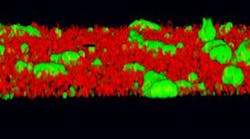New patent on synthetic molecules brings researchers closer to new periodontitis treatment
Donald Demuth, PhD, and Frederick Luzzio, PhD, receive patent for biochemical structure that could provide a promising periodontitis treatment
University of Louisville researchers recently received a patent on a synthetic biochemical compound and its variants, moving science closer to a treatment for gum disease. This discovery could lead to the formulation of a mouth rinse or tooth varnish to prevent the pathogen, Porphyromonas gingivalis from colonizing in the mouth and establishing itself orally.
READ MORE | Thoughtful use of local delivery antimicrobial agents in periodontitis
Dr. Donald Demuth, associate dean for research and enterprise, University of Louisville School of Dentistry, and Dr. Frederick Luzzio, professor, University of Louisville College of Arts & Sciences, Department of Chemistry, developed and tested 40 different molecular compounds, and the three most potent compounds are being further developed.
This patent builds on the previous work of Demuth and other University of Louisville dental school researchers who developed a series of peptides, the building blocks of protein in a cell, that prevent interaction between P. gingivalis and Streptococcus gordonii.
“When P. gingivalis enters the oral environment, it initially interacts with the bacterium S. gordonii—an otherwise benign organism—in order to lay the ground work to propagate and ultimately gain a foothold below the gum line, leading to periodontal disease,” Dr. Demuth said.
Dr. Demuth found that administering the peptide in an animal model prevented P. gingivalis-related bone loss (i.e., the clinical symptom of periodontal disease) and prevented the spread of the bacterium in the mouth. He says creating peptides is expensive, but synthetic compounds that mimic the active peptides are easier to formulate and less costly to produce on a large scale.
Dr. Luzzio and Dr. Demuth hope to improve the potency and stability of the three synthetic molecular structures, and eventually gain approval for a clinical trial.
Editor's note: To keep up with more industry news like this, subscribe to the Apex360 e-newsletter here.
Source: University of Louisville press release 14 December 2015


